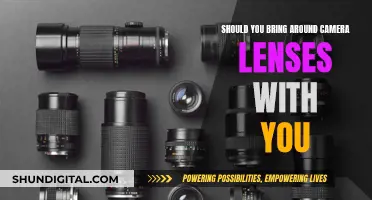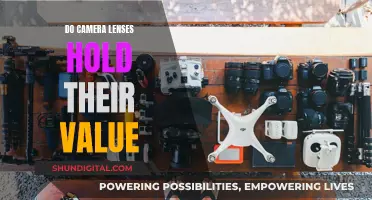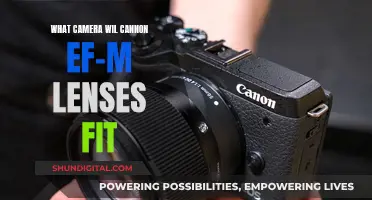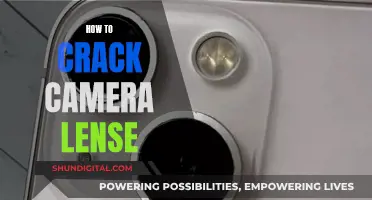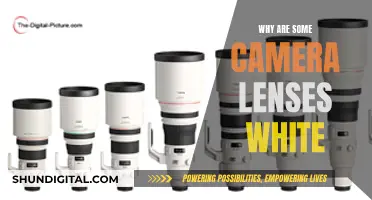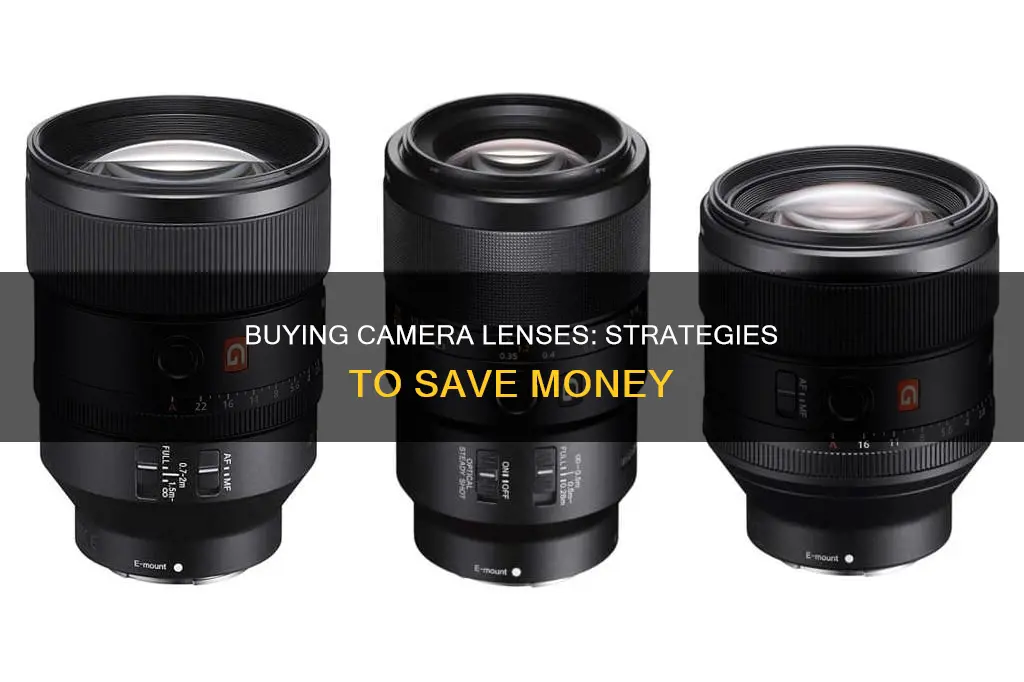
Camera lenses can be expensive, and many people wonder how they can afford them. There are several ways to save money when purchasing camera equipment. One way is to buy used gear from second-hand shops or online. Another way is to look for discounted items, such as open-box lenses or scratched bodies. Additionally, one can also consider buying lenses from alternative brands that offer more affordable options. If you already have some gear, you can sell your old equipment to finance new purchases. It is also a good idea to set a monthly budget or use zero-interest credit cards to pay for expensive items. For those who are freelancers or run their own production company, investing in lenses can be a good way to make passive income by renting them out to other productions.
What You'll Learn

Buy used gear
Used camera gear can be purchased for a fraction of the cost of new gear, often with minimal compromise on quality and longevity. Here are some tips for buying used camera gear:
Buy From a Trustworthy Source
While it is possible to buy used gear from places like eBay, Craigslist, or a yard sale, it is safer to buy from a trustworthy source. Heavy hitters such as Adorama and B&H Photo offer secondhand gear that has been inspected and graded for cosmetic condition and functionality. Used-gear specialists like KEH and MPB offer generous 180-day warranties on their gear, and MPB provides photos of the actual items being sold.
Buy/sell/trade forums like Fredmiranda.com and r/photomarket on Reddit are also safer options than Craigslist or Facebook Marketplace, as they have feedback systems in place to help you vet sellers.
Examine Exterior and Interior Condition
Before conducting any detailed tests with a camera, always make sure to examine the exterior and interior condition of the lens. Look out for scratches and dents, as this will tell you a lot about how the lens was previously used. If the seller has dropped or abused the camera, there will be damage to the glass, and it won't work properly.
Examine screws and rubber pieces holding the lens together—if you see visible marks, it might indicate disassembly/reassembly and potential mechanical or electronic problems. Unless the seller indicates that the lens was repaired by a professional, you might want to stay away from such lenses.
Examine Optical Condition
Check the lens for fungus, scratches, and dust by shining a light through it. Small scratches and dust specs are nothing to worry about and rarely affect image quality. However, keep an eye out for damage to front and rear elements (especially the rear), damage to lens coating, large dust or other particles inside the lens, and a "cloudy" appearance.
Check the Aperture Blades
Before attaching the lens to your camera, visually inspect the aperture blades for any damage. Afterward, use your hand to open and close the aperture blades manually. There should be no delay, and they should move smoothly without any resistance.
Take Test Shots With the Lens
Always bring your camera along and test the lens meticulously by taking multiple shots of different subjects. If the seller doesn't allow you to take test shots, they might be hiding something.
Check the Focus of the Lens
While testing the lens, shoot photos at different focal points and distances. If you hear strange sounds coming from the focusing motor, it might be a sign that it's going to break down soon. Next, switch to manual mode and use your hand to adjust the focus ring. If the ring makes any grating noise or feels like there's sand stuck in it, there may be a problem.
CCD Camera Lenses: Color Corrected or Not?
You may want to see also

Save up for a few months
Saving up for a few months is a great way to afford camera lenses without breaking the bank. Here are some tips to help you save effectively:
Identify your needs
Before you start saving, it's important to identify what you really need in terms of camera gear. Do you need a wide-angle lens for landscape photography, or a zoom lens for more versatility? By determining your specific needs, you can create a targeted savings plan and avoid overspending on gear you might not need.
Set a realistic budget
Consider your financial situation and set a budget that you can comfortably save each month without stretching yourself too thin. Remember, it's important to stick within your budget to avoid any financial strain.
Cut down on unnecessary expenses
Evaluate your spending habits and identify areas where you can cut down on expenses. For example, you could cook at home more often instead of dining out, make coffee at home instead of buying expensive coffee drinks, or cut back on entertainment expenses. These small changes can help you save a significant amount over time.
Create a separate savings account
Consider opening a dedicated savings account specifically for your camera lens fund. This will help you keep your savings separate from your regular expenses and make it easier to track your progress. You can also look for high-yield savings accounts that offer a higher interest rate to maximize your savings.
Automate your savings
Set up automatic transfers from your checking account to your savings account. By automating your savings, you make sure that the money goes directly into your savings account without you having to remember to transfer it manually each month. This helps you save effortlessly and stay on track.
Sell unwanted items
Go through your belongings and identify items that you no longer need or use. You can sell these items online or at a pawn shop to boost your savings. Not only will this help you save up for your camera lens, but it will also declutter your space.
Take on extra work
If you have the time and energy, consider taking on a side hustle or freelance work to boost your income. This could be photography-related, such as offering your services for events or selling your photos, or something completely different. The extra income will help you reach your savings goal faster.
Saving up for a few months requires discipline and commitment, but it can be a rewarding way to afford your desired camera lenses without compromising your financial stability. Remember to stay focused on your goal and be mindful of your spending habits during this period.
Understanding Your Camera Lens' Field of View
You may want to see also

Take up side projects
Taking up side projects is a great way to earn extra income to fund your photography gear upgrades. Here are some tips and insights to help you get started:
- Assess your skills and interests: Think about the types of side projects you would enjoy and excel at. Do you want to focus on photography-related projects, or are you open to other areas? Consider your strengths and what you can offer to potential clients.
- Build a portfolio: Create a portfolio that showcases your best work. This could include sample photos, testimonials from previous clients, or even a website or social media presence to attract potential clients.
- Network and market yourself: Spread the word about your services. Attend industry events, join online communities, and utilise social media platforms to connect with potential clients. Building a strong network can lead to more side project opportunities.
- Start small and be flexible: Begin with smaller projects or offer your services for free to build your reputation. Be open to trying new things and adapting to client needs. This will help you gain experience and build a strong foundation for your side hustle.
- Manage your time effectively: Balancing a side hustle with your main job and personal life can be challenging. Prioritise your time and set clear boundaries to ensure you don't burn out. Effective time management will help you succeed.
- Consider the financial aspects: Determine your rates and how you will handle payments. Be sure to factor in any additional costs, such as equipment, travel, or marketing expenses. Set clear financial goals and track your progress.
- Learn from others: Seek advice and inspiration from other photographers who have successfully taken on side projects. Join online communities or forums where you can connect with like-minded individuals. Learning from the experiences of others can help you avoid common pitfalls and improve your chances of success.
Remember, taking on side projects can be a rewarding way to fund your camera lens upgrades, but it's important to maintain a healthy work-life balance and ensure you're complying with any tax or legal obligations that may arise from your additional income stream.
Camera Lenses: Weatherproof or Not?
You may want to see also

Buy vintage lenses
Vintage lenses are a great option for those looking to save money on their camera equipment. They are often far less expensive than their modern counterparts, but still offer fantastic quality.
Where to buy vintage lenses
There are many online retailers and marketplaces where you can find vintage lenses. These include eBay, Etsy, Facebook Marketplace, and specialist camera shops such as KEH and UsedPhotoPro. You can also find vintage lenses at second-hand shops, charity shops, estate sales, and auctions.
Things to consider
When buying vintage lenses, it is important to consider the condition of the lens and whether it is compatible with your camera. It is also worth noting that vintage lenses may not have the same features as modern lenses, such as autofocus or image stabilisation.
Examples of vintage lenses
Some examples of vintage lenses that can be found online include:
- Canon FD 28mm f/2.8
- Nikon Nikkor-P Auto 1/2.5 105mm
- Voigtlander Super Dynarex 135mm f/4.0
- Canon FD 85mm f/1.2 L Manual Focus Portrait Lens
The Evolution of Camera Lenses: 8 to 10 mm Range
You may want to see also

Invest in assets
Investing in Assets
One way to afford camera lenses is to invest in assets that can help you generate passive income or save money in the long run. Here are some strategies to consider:
Renting out Your Gear
If you own high-quality camera equipment, such as lenses, you can rent them out to other photographers or production companies. This can be a great way to generate additional income and offset the cost of your lenses. There are dedicated websites and platforms that facilitate gear rentals, or you can build connections within your network to find opportunities.
Buying Used Gear
Consider investing in used camera lenses and equipment. Buying used gear can help you save a significant amount of money compared to purchasing brand new items. Just make sure to do your research, buy from reputable sources, and thoroughly inspect the condition of the lenses before purchasing.
Selling Old Gear
If you already have some photography equipment, you can sell your old gear to finance the purchase of new lenses. This strategy allows you to upgrade your equipment while also generating the funds to afford new lenses. It's a way to recycle your old gear and put the money towards something that better suits your current needs.
Investing in Long-Lasting Lenses
When investing in camera lenses, opt for those that will retain their value over time. Some lenses, particularly high-quality vintage lenses, tend to hold their value or even increase in price over the years. These lenses become sought-after by collectors or photographers looking for unique optical characteristics.
Building a Diverse Portfolio
Instead of focusing solely on the latest and greatest lenses, consider building a diverse portfolio of lenses that covers a range of focal lengths and apertures. This approach ensures that you have the right tool for different types of photography and can also help you save money. You might find that you don't need the absolute newest lens model to capture stunning images.
Choosing the Right Camera System
When investing in lenses, it's crucial to choose a camera system that you can stick with for the long haul. Lenses are often proprietary to specific camera brands, so switching systems might require you to start your lens collection from scratch. Do your research, rent or borrow different camera systems, and decide on one that aligns with your photography goals and budget.
By investing wisely in assets and equipment, you can make affording camera lenses more manageable. These strategies can help you generate additional income, save money, and build a sustainable photography kit that suits your needs.
Cameras and Lenses: Capturing the 3D World
You may want to see also
Frequently asked questions
There are several ways to save up for camera lenses. You could save up money from your main job, do side gigs, or sell your old gear. You could also buy used gear, either online or from a pawn shop, and then resell it later for almost the same price.
Buying used gear is one way to save money when purchasing camera lenses. You can also buy from other brands that offer more affordable options, such as Sigma, Tamron, or Samyang. Another option is to buy vintage lenses and converters, which can give your images a unique, pleasing character.
If you're looking for an alternative to purchasing a camera lens, you can consider renting the lens instead. This can be a cost-effective way to try out different lenses before committing to a purchase. Additionally, you can adapt older manual film lenses to newer digital bodies, which may result in a unique and imperfect character to your images.


